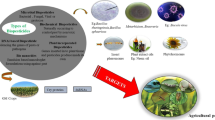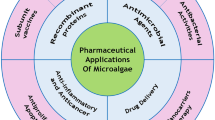Abstract
Cell-penetrating peptides (CPPs) are a group of short, membrane-permeable cationic peptides that represent a nonviral technology for delivering nanomaterials and macromolecules into live cells. In this study, two arginine-rich CPPs, HR9 and IR9, were found to be capable of entering rotifers. CPPs were able to efficiently deliver noncovalently associated with cargoes, including plasmid DNAs, red fluorescent proteins (RFPs), and semiconductor quantum dots, into rotifers. The functional reporter gene assay demonstrated that HR9-delivered plasmid DNAs containing the enhanced green fluorescent protein and RFP coding sequences could be actively expressed in rotifers. The 1-(4,5-dimethylthiazol-2-yl)-3,5-diphenylformazan assay further confirmed that CPP-mediated cargo delivery was not toxic to rotifers. Thus, these two CPPs hold a great potential for the delivery of exogenous genes, proteins, and nanoparticles in rotifers.








Similar content being viewed by others
Abbreviations
- CPPs:
-
Cell-penetrating peptides
- Cy3:
-
Cyanine 3
- DMSO:
-
Dimethyl sulfoxide
- dsRNA:
-
Double-stranded RNA
- EGFP:
-
Enhanced green fluorescent protein
- FITC:
-
Fluorescein isothiocyanate
- GFP:
-
Green fluorescent protein
- HA2:
-
Hemagglutinin-2
- 6His:
-
Hexa-histidine
- N/P:
-
Nitrogen/phosphate
- MTT:
-
1-(4,5-Dimethylthiazol-2-yl)-3,5-diphenylformazan
- QDs:
-
Quantum dots
- R9:
-
Nona-arginine
- RFP:
-
Red fluorescent protein
- siRNA:
-
Small interfering RNA
References
Bolhassani A, Safaiyan S, Rafati S (2011) Improvement of different vaccine delivery systems for cancer therapy. Mol Cancer 10:3
Chang M, Chou JC, Lee HJ (2005a) Cellular internalization of fluorescent proteins via arginine-rich intracellular delivery peptide in plant cells. Plant Cell Physiol 46:482–488
Chang M, Hsu HY, Lee HJ (2005b) Dye-free protein molecular weight markers. Electrophoresis 26:3062–3068
Chang M, Chou JC, Chen CP, Liu BR, Lee HJ (2007) Noncovalent protein transduction in plant cells by macropinocytosis. New Phytol 174:46–56
Chen F, Gerion D (2004) Fluorescent CdSe/ZnS nanocrystal–peptide conjugates for long-term, nontoxic imaging and nuclear targeting in living cells. Nano Lett 4:1827–1832
Chen CP, Chou JC, Liu BR, Chang M, Lee HJ (2007) Transfection and expression of plasmid DNA in plant cells by an arginine-rich intracellular delivery peptide without protoplast preparation. FEBS Lett 581:1891–1897
Chen YJ, Liu BR, Dai YH, Lee CY, Chan MH, Chen HH, Chiang HJ, Lee HJ (2012) A gene delivery system for insect cells mediated by arginine-rich cell-penetrating peptides. Gene 493:201–210
Dahms HU, Hagiwara A, Lee JS (2011) Ecotoxicology, ecophysiology, and mechanistic studies with rotifers. Aquat Toxicol 101:1–12
Dai YH, Liu BR, Chiang HJ, Lee HJ (2011) Gene transport and expression by arginine-rich cell-penetrating peptides in Paramecium. Gene 489:89–97
Deshayes S, Konate K, Aldrian G, Crombez L, Heitz F, Divita G (2010) Structural polymorphism of non-covalent peptide-based delivery systems: highway to cellular uptake. Biochim Biophys Acta 1798:2304–2314
Feder D, Gomes SAO, de Thomaz AA, Almeida DB, Faustino WM, Fontes A, Stahl CV, Santos-Mallet JR, Cesar CL (2009) In vitro and in vivo documentation of quantum dots labeled Trypanosoma cruzi–Rhodnius prolixus interaction using confocal microscopy. Parasitol Res 106:85–93
Frankel AD, Pabo CO (1988) Cellular uptake of the Tat protein from human immunodeficiency virus. Cell 55:1189–1193
Gama Sosa MA, De Gasperi R, Elder GA (2010) Animal transgenesis: an overview. Brain Struct Funct 214:91–109
Green M, Loewenstein PM (1988) Autonomous functional domains of chemically synthesized human immunodeficiency virus Tat trans-activator protein. Cell 55:1179–1188
Gump JM, Dowdy SF (2007) TAT transduction: the molecular mechanism and therapeutic prospects. Trends Mol Med 13:443–448
Hannon GJ (2002) RNA interference. Nature 418:244–251
Holbrook RD, Murphy KE, Morrow JB, Cole KD (2008) Trophic transfer of nanoparticles in a simplified invertebrate food web. Nat Nanotechnol 3:352–355
Hou YW, Chan MH, Hsu HR, Liu BR, Chen CP, Chen HH, Lee HJ (2007) Transdermal delivery of proteins mediated by non-covalently associated arginine-rich intracellular delivery peptides. Exp Dermatol 16:999–1006
Hu JW, Liu BR, Wu CY, Lu SW, Lee HJ (2009) Protein transport in human cells mediated by covalently and noncovalently conjugated arginine-rich intracellular delivery peptides. Peptides 30:1669–1678
Jo J, Tabata Y (2008) Non-viral gene transfection technologies for genetic engineering of stem cells. Eur J Pharm Biopharm 68:90–104
Kim GY, Moon JM, Han JH, Kim KH, Rhim H (2011) The sCMV IE enhancer/promoter system for high-level expression and efficient functional studies of target genes in mammalian cells and zebrafish. Biotechno Lett 33:1319–1326
Lee CY, Li JF, Liou JS, Charng YC, Huang YW, Lee HJ (2011) A gene delivery system for human cells mediated by both a cell-penetrating peptide and a piggyBac transposase. Biomaterials 32:6264–6276
Li JF, Huang Y, Chen RL, Lee HJ (2010) Induction of apoptosis by gene transfer of human TRAIL mediated by arginine-rich intracellular delivery peptides. Anticancer Res 30:2193–2202
Liou JS, Liu BR, Martin AL, Huang YW, Chiang HJ, Lee HJ (2012) Protein transduction in human cells is enhanced by cell-penetrating peptides fused with an endosomolytic HA2 sequence. Peptides 37:273–284
Liu K, Lee HJ, Leong SS, Liu CL, Chou JC (2007) A bacterial indole-3-acetyl-l-aspartic acid hydrolase inhibits mung bean (Vigna radiata L.) seed germination through arginine-rich intracellular delivery. J Plant Growth Regul 26:278–284
Liu BR, Chou JC, Lee HJ (2008) Cell membrane diversity in noncovalent protein transduction. J Membr Biol 222:1–15
Liu BR, Li JF, Lu SW, Lee HJ, Huang YW, Shannon KB, Aronstam RS (2010a) Cellular internalization of quantum dots noncovalently conjugated with arginine-rich cell-penetrating peptides. J Nanosci Nanotechnol 10:6534–6543
Liu BR, Huang YW, Chiang HJ, Lee HJ (2010b) Cell-penetrating peptide-functionalized quantum dots for intracellular delivery. J Nanosci Nanotechnol 10:7897–7905
Liu BR, Huang YW, Winiarz JG, Chiang HJ, Lee HJ (2011) Intracellular delivery of quantum dots mediated by a histidine- and arginine-rich HR9 cell-penetrating peptide through the direct membrane translocation mechanism. Biomaterials 32:3520–3537
Liu BR, Lin MD, Chiang HJ, Lee HJ (2012) Arginine-rich cell-penetrating peptides deliver gene into living human cells. Gene 505:37–45
Liu BR, Huang YW, Chiang HJ, Lee HJ (2013a) Primary effectors in the mechanisms of transmembrane delivery of arginine-rich cell-penetrating peptides. Adv Stud Biol 5:11–25
Liu MJ, Chou JC, Lee HJ (2013b) A gene delivery method mediated by three arginine-rich cell-penetrating peptides in plant cells. Adv Stud Biol 5:71–88
Lu SW, Hu JW, Liu BR, Lee CY, Li JF, Chou JC, Lee HJ (2010) Arginine-rich intracellular delivery peptides synchronously deliver covalently and noncovalently linked proteins into plant cells. J Agric Food Chem 58:2288–2294
Madani F, Lindberg S, Langel U, Futaki S, Graslund A (2011) Mechanisms of cellular uptake of cell-penetrating peptides. J Biophys 2011:414729
Mager I, Langel K, Lehto T, Eiriksdottir E, Langel U (2012) The role of endocytosis on the uptake kinetics of luciferin-conjugated cell-penetrating peptides. Biochim Biophys Acta 1818:502–511
May RC, Plasterk RH (2005) RNA interference spreading in C. elegans. Methods Enzymol 392:308–315
Michalet X, Pinaud FF, Bentolila LA, Tsay JM, Doose S, Li JJ, Sundaresan G, Wu AM, Gambhir SS, Weiss S (2005) Quantum dots for live cells, in vivo imaging, and diagnostics. Science 307:538–544
Nakase I, Kobayashi S, Futaki S (2010) Endosome-disruptive peptides for improving cytosolic delivery of bioactive macromolecules. Biopolymers 94:763–770
Oo AKS, Kaneko G, Hirayama M, Kinoshita S, Watabe S (2010) Identification of genes differentially expressed by calorie restriction in the rotifer (Brachionus plicatilis). J Comp Physiol B 180:105–116
Pfannkuchen M, Brummer F (2009) Heterologous expression of DsRed2 in young sponges (Porifera). Int J Dev Biol 53:1113–1117
Piedrahita JA, Olby N (2011) Perspectives on transgenic livestock in agriculture and biomedicine: an update. Reprod Fertil Dev 23:56–63
Plank C, Oberhauser B, Mechtler K, Koch C, Wagner E (1994) The influence of endosome-disruptive peptides on gene transfer using synthetic virus-like gene transfer systems. J Biol Chem 269:12918–12924
Schmidt N, Mishra A, Lai GH, Wong GC (2010) Arginine-rich cell-penetrating peptides. FEBS Lett 584:1806–1813
Shaner NC, Campbell RE, Steinbach PA, Giepmans BNG, Palmer AE, Tsien RY (2004) Improved monomeric red, orange and yellow fluorescent proteins derived from Discosoma sp. red fluorescent protein. Nat Biotechnol 22:1567–1572
Shearer TL, Snell TW (2007) Transfection of siRNA into Brachionus plicatilis (Rotifera). Hydrobiologia 593:141–150
Snell TW, Hicks DG (2011) Assessing toxicity of nanoparticles using Brachionus manjavacas (Rotifera). Environ Toxicol 26:146–152
Snell TW, Shearer TL, Smith HA, Kubanek J, Gribble KE, Welch DBM (2009) Genetic determinants of mate recognition in Brachionus manjavacas (Rotifera). BMC Biol 7:60
Snell TW, Shearer TL, Smith HA (2011) Exposure to dsRNA elicits RNA interference in Brachionus manjavacas (Rotifera). Mar Biotechnol 13:264–274
Son SW, Kim JH, Kim SH, Kim H, Chung AY, Choo JB, Oh CH, Park HC (2009) Intravital imaging in zebrafish using quantum dots. Skin Res Technol 15:157–160
Stylianou P, Skourides PA (2009) Imaging morphogenesis, in Xenopus with quantum dot nanocrystals. Mech Dev 126:828–841
Suhr ST, Ramachandran R, Fuller CL, Veldman MB, Byrd CA, Goldman D (2009) Highly-restricted, cell-specific expression of the simian CMV-IE promoter in transgenic zebrafish with age and after heat shock. Gene Expr Patterns 9:54–64
Swanson KS, Mazur MJ, Vashisht K, Rund LA, Beever JE, Counter CM, Schook LB (2004) Genomics and clinical medicine: rationale for creating and effectively evaluating animal models. Exp Biol Med 229:866–875
van den Berg A, Dowdy SF (2011) Protein transduction domain delivery of therapeutic macromolecules. Curr Opin Biotechnol 22:888–893
Wadia JS, Dowdy SF (2002) Protein transduction technology. Curr Opin Biotechnol 13:52–56
Wang YH, Chen CP, Chan MH, Chang M, Hou YH, Chen HH, Hsu HR, Liu K, Lee HJ (2006) Arginine-rich intracellular delivery peptides noncovalently transport protein into living cells. Biochem Biophys Res Commun 346:758–767
Wang YH, Hou YW, Lee HJ (2007) An intracellular delivery method for siRNA by an arginine-rich peptide. J Biochem Biophys Methods 70:579–586
Xu Y, Liu BR, Lee HJ, Shannon KS, Winiarz JG, Wang TC, Chiang HJ, Huang YW (2010) Nona-arginine facilitates delivery of quantum dots into cells via multiple pathways. J Biomed Biotechnol 2010:948543
Yu WW, Qu L, Guo W, Peng X (2003) Experimental determination of the extinction coefficient of CdTe, CdSe, and CdS nanocrystals. Chem Mater 15:2854–2860
Zhang Y, Wang TH (2012) Quantum dot enabled molecular sensing and diagnostics. Theranostics 2:631–654
Acknowledgments
We thank Roger Y. Tsien (University of California, San Diego, CA, USA) for provision of the mCherry plasmid, Goo-Young Kim and Hyangshuk Rhim (The Catholic University of Korea, Seoul, Korea) for the pCS2+ EGFP plasmid, Daniel Goldman (University of Michigan, Ann Arbor, MI, USA) for the pCS2+ DsRed plasmid, Chia-Wei Huang for the construction of the pCS2+ mCherry plasmid, Tze-Bin Chou (National Taiwan University, Taipei, Taiwan) and Core Instrument Center (National Health Research Institutes, Miaoli, Taiwan) for the Leica confocal systems, Institute of Cellular and Systems Medicine (National Health Research Institutes, Miaoli, Taiwan) for the Olympus microscope, and Robert S. Aronstam (Missouri University of Science and Technology, USA) for technical editing. This work was supported by Postdoctoral Fellowship NSC 101-2811-B-259-001 (to B.R.L.) and Grant Number NSC101-2311-B-259-003-MY3 (to H-J.L.) from the National Science Council of Taiwan.
Author information
Authors and Affiliations
Corresponding author
Electronic supplementary material
Below is the link to the electronic supplementary material.
ESM 1
(DOCX 1.72 mb)
Rights and permissions
About this article
Cite this article
Liu, B.R., Liou, JS., Chen, YJ. et al. Delivery of Nucleic Acids, Proteins, and Nanoparticles by Arginine-Rich Cell-Penetrating Peptides in Rotifers. Mar Biotechnol 15, 584–595 (2013). https://doi.org/10.1007/s10126-013-9509-0
Received:
Accepted:
Published:
Issue Date:
DOI: https://doi.org/10.1007/s10126-013-9509-0




